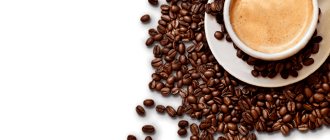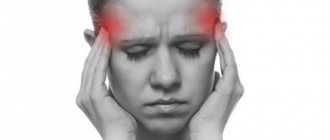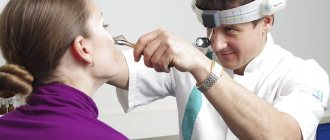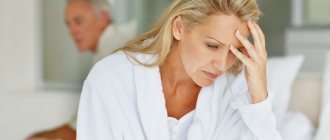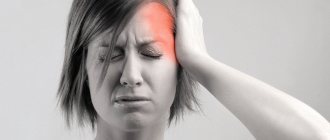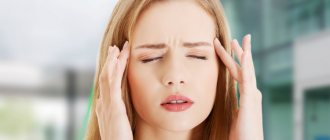Causes of headaches during exercise
Headaches during exercise can occur directly during or after exercise. It occurs for various reasons - some of them are safe for humans, but others require complex diagnosis and treatment. Doctors recommend stopping training immediately and not continuing to exercise if you have a headache. As a result of the examination, various disorders may be detected, including high blood pressure, migraine, acute and chronic vascular diseases and others.
Hypertension
Main article: Headache due to hypertension
A slight increase in blood pressure during exercise is called physiological hypertension and is within normal limits. This is due to the increased need of cells and tissues for oxygen, which is necessary for the formation of energy. However, this condition is not accompanied by a headache, and the pressure quickly recovers after the end of the session.
Headache, weakness, dizziness, redness of the skin and mucous membranes are symptoms of hypertension. It is diagnosed if blood pressure at rest is 140/90 mm. rt. Art. and more. The disease may be associated with deterioration of the vascular walls, heart disease, excess weight, poor diet and other factors.
To determine the signs of hypertension, just use a tonometer. A test that is performed several times, before and after physical activity, has diagnostic significance. Below is an algorithm on how to correctly measure blood pressure in order to exclude dangerous diseases of the heart and blood vessels.
- Measure the pressure on your right arm using a tonometer. In a healthy person at rest, the readings will be 120/80 mm. rt. Art., but not more than 130/80 mm. rt. Art.
- Without removing the tonometer cuff, perform 10 squats (for athletes and physically active people, a set of 20 squats would be informative) at an active pace, and after that, immediately measure the pressure again. It may remain unchanged, but it is also considered normal to increase it to 140/80 mm. rt. Art.
- Remain at rest for a minute, then change the pressure again. During this time, the indicators should completely return to normal. If the pressure increases even slightly, but does not recover for a long time, this may indicate various diseases of the heart and blood vessels.
At the first symptoms of hypertension, you should make an appointment with a doctor for a more detailed examination. At the Clinical Brain Institute, registration is carried out online and by telephone. It is important to understand that playing sports with this disease is contraindicated, especially during an exacerbation. This can lead to a critical increase in blood pressure and the development of a stroke. The doctor will also prescribe medications to regulate blood pressure, improve the condition of blood vessels and eliminate the main cause of hypertension.
Vascular diseases
Vascular disease is one of the reasons why headaches occur during physical activity. During exercise, the brain needs a large amount of oxygen, therefore, with insufficient blood circulation, it experiences ischemia (oxygen starvation). This leads to acute headaches, dizziness, nausea and can even cause fainting.
A common vascular disease is atherosclerosis. It often appears in old age and is associated with decreased elasticity of the arteries. Their walls become dense and grow with connective tissue. The process is accompanied by sudden changes in pressure, since the mechanisms of vascular regulation do not have time to respond to changes in external factors. Atherosclerosis can occur for several reasons:
- age-related changes and slowing of metabolism, which leads to weakness of the walls of blood vessels;
- increased levels of cholesterol and harmful lipoproteins in the blood - they are deposited on the inner surface of the arteries and over time can form plaques and blood clots;
- excess weight – often provokes the development of vascular diseases;
- unhealthy diet – the diet contains a large amount of animal fats, fried foods and spices, sweets and baked goods;
- an inactive lifestyle is one of the main reasons for a decrease in the elasticity and strength of blood vessels and a slowdown in blood circulation.
To prevent vascular health, it is important to carry out moderate physical activity. This promotes blood movement and training of vascular walls. If atherosclerosis, cholesterol metabolism disorders and other diseases are diagnosed, you must follow the advice of your doctor. He may prescribe drugs to remove cholesterol, drugs to strengthen blood vessels and improve blood supply to the brain. You will also need a special diet with a minimum amount of harmful foods.
Migraine
Migraine is the primary headache. It often occurs simultaneously in several family members, and the involvement of nervous and vascular factors in its development has also been proven. The diagnosis is made based on MRI or CT scan data of the brain, as well as the general clinical picture. The difference between this disease and other disorders that manifest similar symptoms:
- absence of organic brain damage, acute and chronic diseases of the heart and blood vessels;
- the presence of an “aura” - a symptom complex that includes dizziness, nausea, sensory disturbances and manifests itself immediately before a headache attack;
- unilateral manifestation of pain - it often occurs only on the left or right side.
Migraines can first appear at any age. It is characterized by a chronic, wave-like course with alternating exacerbations and periods of remission. Patients often observe certain patterns in the development of the disease. A headache attack can be triggered by changes in weather and atmospheric pressure, stress, disruption of the sleep schedule, as well as intense physical activity. Another peculiarity of migraine is that it does not go away after taking conventional painkillers. To relieve symptoms, the doctor prescribes specific potent drugs.
Other reasons
Muscle tension, increased heart rate, and increased metabolism are natural changes that occur during exercise. In a healthy person, the body adapts to them, so there is no discomfort or pain. Their appearance may indicate various conditions and disorders that require timely treatment.
- Dehydration is common during training, especially for beginners. Trainers recommend drinking a sufficient amount of regular mineral water during the session.
- Vitamin deficiency, as well as deficiency of microelements, is diagnosed as a result of laboratory blood tests. Due to a lack of magnesium, sodium, potassium and calcium, as well as B vitamins, nerve transmission processes worsen. This leads to headaches that get worse during physical activity. Based on the results of the examination, the doctor prescribes medications that compensate for the deficiency of vitamins and minerals.
- A sharp decrease in blood glucose is often the result of an unbalanced diet. Strict diets and calorie deficits affect your well-being because your body needs a lot of energy during exercise.
- Improper execution of exercises, especially failure to comply with breathing techniques, is dangerous to health. It is important to work with a trainer, especially in the initial stages, to avoid pain and deterioration in well-being.
Doctors at the Clinical Institute of the Brain recommend that you undergo an examination if you regularly experience headaches during exercise. It can indicate various disorders, especially if it occurs frequently and with high intensity.
Post-workout headache: when to see a doctor?
Doctors are categorical: if you have a headache after every workout, you should not delay visiting a specialist.
“For any systematically occurring headache, it would be right to consult a neurologist to understand the reasons for what is happening and analyze all the concerns that usually worry people with this symptom, learn how to properly cope with headache attacks, and also get recommendations for their prevention,” believes Julia Hazime.
You should also visit a doctor if you notice strange sensations after exercise.
“If a headache after a regular workout occurs for the first time and is different from what you experienced before, or if in addition to it there are some other symptoms,” says Julia Hazime.
Do you feel a severe headache during training? Perhaps this is a sign of vascular disorders.
“This kind of pain is also called “thundering pain.” It is distinguished by its extraordinary strength: 10 points out of 10. Any attack of “thundering” headache requires mandatory consultation with a doctor. And if immediately after training other neurological symptoms appear, for example, loss of consciousness or convulsions, uncontrollable vomiting, and so on, you should urgently call an ambulance,” warns Yulia Hazime.
“Red flags (danger symptoms) are associated symptoms with headache, for example, weakness on one side of the body, depression of consciousness, change in headache pattern, increased tone in the neck (inability to bring the chin to the sternum), which requires immediate medical attention" , says Konstantin Makhinov.
Methods for diagnosing and treating headaches
When headaches occur, it is important to determine their cause. For this purpose, examination methods such as general and biochemical blood tests, electrocardiography, MRI or CT scan of the brain are prescribed. It is also necessary to distinguish between diseases of the spine, which are accompanied by similar symptoms: osteochondrosis, intervertebral hernia, curvature of the spinal column. After determining an accurate diagnosis, the doctor will prescribe effective treatment. The scheme may include the following steps:
- taking painkillers for migraines;
- drugs to improve blood supply to the brain;
- vitamin complexes and microelements;
- drugs to remove cholesterol and reduce its concentration in the blood;
- medications to support heart function.
At the Clinical Brain Institute, you can undergo a full examination if you experience headaches during training. To make an appointment, simply call, provide your name and insurance policy number, and select a convenient date and time. The doctor will select an individual treatment regimen that will allow you to get rid of not only unpleasant symptoms, but also the main cause of pain and discomfort.
Why do you get a headache after exercise?
Primary post-exercise headaches can occur for many reasons. Let's look at the main ones.
“There are several possible reasons: an increase in pressure in the body from receiving a load (can occur in conjunction with a reaction to an increase in atmospheric pressure), narrowing of blood vessels (together with the vessels of the brain), various restrictions on the mobility of the cervical vertebrae (compression of the canals and bundles of the nervous system). Headaches have little to do with the type of exercise itself, since they can occur during different workouts - cardio, strength, even functional,” says Ruslan Panov, expert methodologist of the X-Fit network in Russia.
Prevention methods
Before starting sports, it is recommended to undergo a full examination. Tests will show how much load can be carried without harm to health. Doctors also have some tips on how to prevent headaches:
- monitor your diet - avoid fatty foods, excess salt and sugar, while consuming enough vitamins and microelements;
- bear optimal loads and do not perform exercises without prior preparation;
- lead an active lifestyle not only during classes, but also during the day;
- work out with a trainer and follow all his instructions during exercises;
- Stop exercising if a headache occurs.
The Clinical Brain Institute offers individual diagnostic and treatment programs for patients who experience headaches during exercise. When the first symptoms appear, you should make an appointment with a doctor. Our center also offers online registration - for this you must provide your name and contact information, as well as your insurance policy number. Next, you need to show up at the specified time for your appointment and follow all the doctor’s instructions.
Clinical Brain Institute Rating: 5/5 — 1 votes
Share article on social networks

